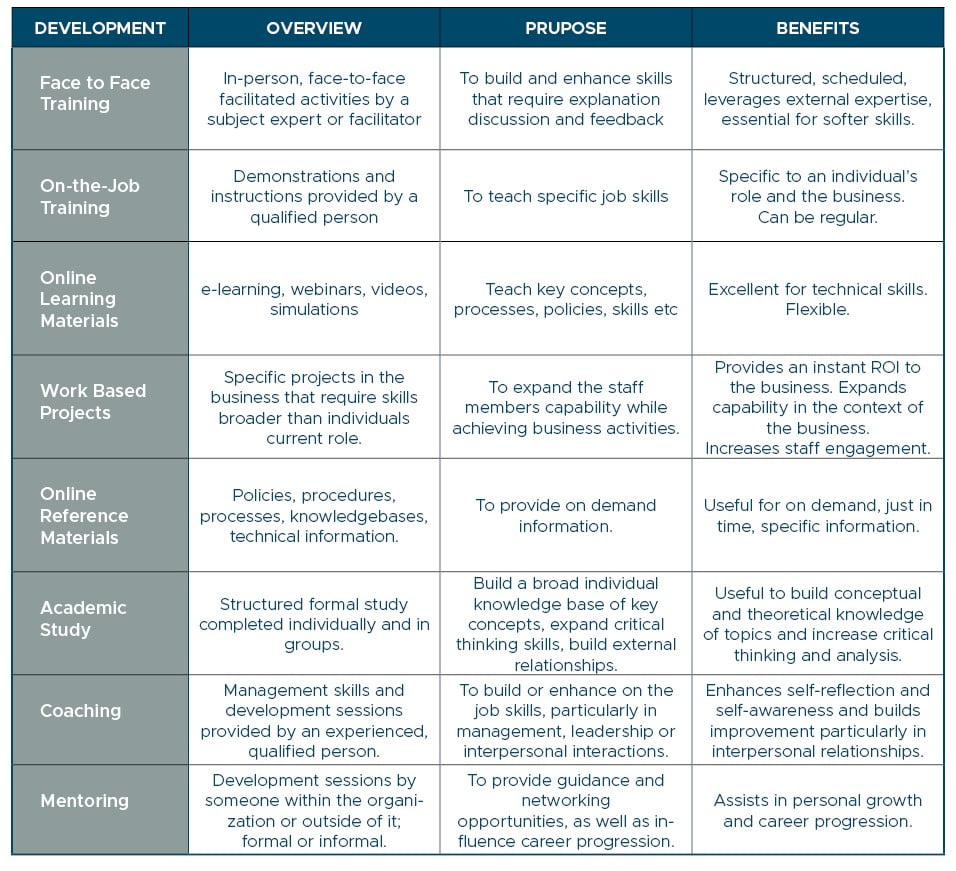The pool of skilled and competent staff is shrinking, especially for highly skilled roles. Even in entry level roles finding staff with an ounce of “common sense” and who will turn up can be challenging.
And if you do find these people, why do they want to work for you?
Which leads to the importance of ongoing training and development.
Instead of looking for someone who ticks all the boxes, you want to attract people with the right attitude, a desire to learn and evidence of historical consistency and achievement, not just someone looking for a pay cheque.
For existing staff these factors are equally important. A key method of retaining staff is opportunities for their ongoing learning and development.
Personal growth cannot be underestimated in calculating job satisfaction.
Why Training and Development?
Research has consistently shown that training and development enhances employee retention, especially in tight labour markets. Staff feel greater loyalty and satisfaction with regular training and development.
Below is a table of approaches to learning and development within organisations. There are a broad range of options and not one size fits all. The key is to make training and development a priority in your business, to help with both attraction and retention.
Here are a few pointers that can help…
Onboarding
When a new staff member joins your organisation you should have a structured onboarding process. Don’t just hand them a security pass and show them where the toilets are. The onboarding process is where the training and development starts.
In the People & Culture | Retaining and Building Culture Masterclass. Mandy Johnson outlines a few key points in relation to onboarding:
- Do they feel inspired?
- Do they feel valued?
- Is there somewhere to go with my queries or concerns?
Research suggests that new employees who went through a structured onboarding program were 58 percent more likely to be with the organisation after three years and Walmart found that 67% of new staff turnover happened in the first 90 days.
Onboarding makes a difference.
Leadership Development
Development and leadership programs can often be seen as timewasters, but we can assure you that investing in your managers and team leaders – even yourself as the business owner – is vital for your business to be successful.
Research consistently shows that the number one reason that people leave is their direct manager. Investing in leadership skills and programs can pay significant dividends by increasing retention and improving staff engagement and performance.
The best leadership programs for small to medium businesses are those that surround you with like-minded people, provide practical tools and application, and develop both staff in the context of their role and the business.
Australian Owner Manager programs, such as OM Leadership Program, Team Leader Masterclass, the Owner Manager Program and the Small Business Owner Program, all focus on real world application, providing participants with the tools and knowledge to then apply what they are learning immediately.
Internal coaching
Internal coaching is a flow on effect from your leadership team attending development programs. Once they learn to be better leaders and managers, they will be well-equipped to coach their team members to reach KPIs, find solutions and work better as a team. Having a manager that you respect and can learn from, is a key step to building a thriving workplace.
As mentioned above, a bad manager is the number one reason people leave their jobs – develop your leaders and the flow on effect is transformational!
External Training Courses
For many roles, continued learning is a must to stay up to date with emerging technologies, new procedures or updated safety requirements. From lawyers to electricians, most roles require some additional training, and it is up to the business owner to ensure their staff are up to date.
Investing in industry training or in-house training is a no brainer and should be scheduled regularly.
Above all it can be a cost-effective mechanism to reduce staff turnover and provide a return to the business.
Work-based projects
Work-based projects are an underutilised mechanism to help participants learn on the job and apply what they are learning immediately and see visible results. These projects can contribute real value to the business, offering a better learning experience than copious amounts of theory, which is often provided in academic environments.
Participants in the OM Leadership Program and Team Leader Masterclass undertake a work based project specific to their situation and agreed by senior leaders or the owners of the business. This is to ensure the best possible outcomes in terms of strengthening the integration of strategic thinking and ensure application of the learning.
The project will be carefully selected to build on aspects of business development that are central to the company’s strategy.
Conclusion
In the current tight labour market training and development should continue to be a priority. In most cases it is more cost effective to train than to replace if the person has the right attitude.
Don’t be tempted with increasing overheads to annihilate the training budget as you may well end up paying for it in finding and recruitment.
If you want to discuss your particular situation or the specific needs of your staff, by all means get in touch.
Approaches to Learning and Development

Sign Up to Owner Manager Updates
Get tips, advice, useful resources and program updates designed to help business owners and their managers build better businesses…







